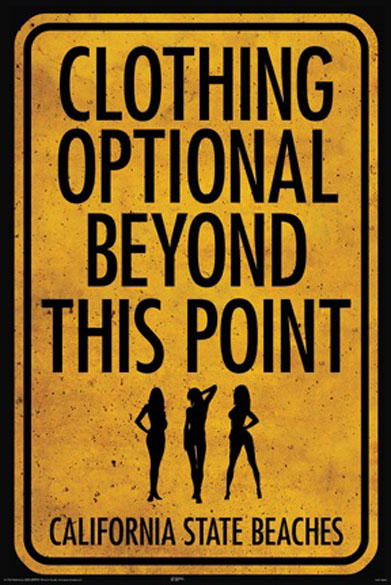In contemporary societal frameworks, the interplay between cultural norms and human behavior often creates a mosaic of interpretations and responses. The phrase “Clothing Is Optional Beyond This Point” exemplifies this phenomenon, enticing individuals to contemplate not only the humor embedded in the message but also the broader implications of cultural relativism. This phrase acts as a remarkable lens, directing our attention toward how divergent cultures negotiate the parameters of social conduct, particularly regarding the human body and its adornments.
At first glance, the humorous nature of the sign may evoke laughter or amusement. However, beneath this surface lies a profound reflection on societal constructs and personal freedom. The juxtaposition of the intended levity with deeper philosophical inquiries offers fertile ground for anthropological exploration. What does it signify when a culture grants permission for nudity within certain contexts? This question serves as a portal into the vast complexities of cultural perspectives on modesty, freedom, and individual expression.
To embark on this exploration, it is vital to acknowledge the nuances of cultural relativism itself. Cultural relativism posits that norms and values are not universal but rather contextually bound, presenting a challenge to ethnocentric views. Herein lies the crux: how does one reconcile their own cultural assumptions with those that permit or even celebrate nudity? Such a reconciliation demands an openness to understand and appreciate alternative frameworks of thought and self-expression.
When considering the permissibility of nudity, it is crucial to examine historical contexts and geographic variations that influence cultural stances on clothing. For instance, numerous indigenous tribes around the world have traditionally maintained minimal clothing as an expression of identity, connection to nature, or social status. This long-standing practice stands in stark contrast to views held by many modern, urban societies that often equate nudity with shame or impropriety. The sign thus becomes a humorous invitation to traverse the chasm between these divergent cultural landscapes.
Furthermore, the location of such signage is no mere accident. Placing a directive indicating that clothing is optional can evoke intrigue and challenge preconceived notions. Public spaces, beaches, and resorts frequently adopt this playful approach to foster enjoyment and liberation. However, this raises pertinent questions: Are we prepared to embrace differing cultural narratives, or do we cling to established norms? As societal acceptance of diverse modes of expression grows, so too does the need for continual dialogue about bodily autonomy and the societal expectations surrounding it.
As one delves deeper, questions of consent and agency emerge. In cultures that embrace nudity, the notion of voluntary participation often underscores the ethos. Individuals participating in such scenarios frequently convey a sense of empowerment, claiming ownership over their bodies in a way that defies conventional modesty norms. Yet, the humor of the sign can also mask underlying tensions surrounding consent and body politics, as one must consider who feels welcome in these “optional” spaces and who may feel marginalized or excluded due to societal pressures. The interplay of humor and deeper inquiry thus becomes pivotal in assessing how the sign reconciles individual liberties with collective cultural expectations.
The challenge posed by the sign is multifold. It serves not only as a playful nudge towards the acceptance of alternative ways of being but also as a reminder that cultural relativism demands engagement with discomforting truths. As individuals are encouraged to examine their biases, they confront not only their personal hesitancies but also the broader social legislation that governs body image and expression. How then, can humor act as a vehicle for critical thought and empathy in this realm? The provocative nature of the sign invites discourse and reflection, encouraging an intersectional approach that grapples with themes of gender, sexuality, and body autonomy.
Indeed, the comedic aspect of the sign facilitates a dialogue on cultural norms by employing irony and absurdity. It subtly critiques the rigid boundaries often erected by societal standards of decency while also beckoning us to laugh at our own discomforts. This duality—recognizing the humor while engaging with its implications—reflects the anthropological spirit of inquiry that encourages individuals to embrace complexity over simplicity.
The humorous narrative surrounding the sign ultimately invokes a timeless challenge faced by societies as they navigate the shifting sands of cultural expectations. What constitutes modesty or appropriateness in one culture may well be an anathema in another. In this light, “Clothing Is Optional Beyond This Point” resonates not solely as an invitation to shed clothing but rather as a clarion call for individuals to confront their ingrained perceptions and biases. It underscores the need for an ongoing examination of body politics, freedom of expression, and the myriad of cultural interpretations that permeate our globalized world.
In conclusion, the sign, while initially humorous, opens a rich vein for anthropological discourse steeped in cultural relativism. It urges individuals to engage with the multiplicity of human experience, challenging normative beliefs surrounding the relationship between clothing and identity. Through this exploration, the synthesis of humor and critical inquiry becomes not just an academic exercise but a vital component of social progress and mutual understanding in an increasingly diverse world.
